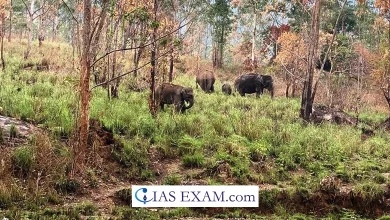Daily Current Affairs for UPSC
National Clean Air Programme (NCAP)
Topic- Government Policies and Interventions [GS Paper-2]
Context- Recently, the Central government has set a new target of a 40% reduction in particulate matter concentration in cities covered under the National Clean Air Programme (NCAP) by 2026, updating the earlier goal of 20 to 30% reduction by 2024.
Key Highlights
- As per the Union Environment Ministry, 95 of the 131 non-attainment cities covered under the National Clean Air Programme have witnessed an improvement in PM10 levels in 2021 as compared to 2017 levels.
- Twenty cities, including Chennai, Madurai and Nashik, have achieved the national standards for annual average PM10 concentration i.e. 60 microgram per cubic metre.
- Whereas the acceptable annual standard for PM 2.5 is 40 micrograms per cubic metre.
- PM 2.5 are fine inhalable particles, with diameters that are generally 2.5 micrometers and smaller, and cause the greatest risk to health.
- However the 132 cities covered under the NCAP failed to meet the prescribed national ambient air quality standards for five consecutive years (2011-2015).
- Hence the government has set a goal of 20 to 30% reduction in PM levels by 2024 and 40% by 2026.
- In order to achieve the targets, city-specific action plans have been prepared which include measures for strengthening the air quality monitoring network, reducing vehicular and industrial emissions, increasing public awareness, etc.
- Cities that have improvement in PM 10 concentration since 2017 include Delhi, Noida, Ghaziabad, Mumbai, Kolkata, Chennai, Bengaluru, Chandigarh, Dehradun, Patna, Nagpur, Pune, Agra, Allahabad, Bareilly, Firozabad, Moradabad, Kanpur, Varanasi, Jalandhar, Ludhiana, Jaipur, Jodhpur, Jamshedpur, Ranchi, Raipur among others.
National Clean Air Programme
- NCAP was launched by the Ministry of Environment, Forests and Climate Change (MoEFCC) in January 2019.
- It is the first of its kind scheme in India to frame a national framework for air quality management with a time-bound reduction target.
- The programme seeks to cut the concentration of coarse i.e. particulate matter of diameter 10 micrometer or less, or PM10 and fine particles i.e. particulate matter of diameter 2.5 micrometer or less, or PM2.5 by at least 20% in the next five years, with 2017 as the base year for comparison.
- It covers a total of 132 non-attainment cities identified by the Central Pollution Control Board (CPCB) i.e. the cities that have fallen short of the National Ambient Air Quality Standards (NAAQS) for over five years.
- NAAQS are the standards for ambient air quality with reference to various identified pollutants listed by the CPCB under the Air Prevention and Control of Pollution Act, 1981.
- List of pollutants under NAAQS include PM10, PM2.5, SO2, NO2, CO, NH3, Ozone, Lead, Benzene, Benzo-Pyrene, Arsenic and Nickel.
- Objective of NCAP
- To formulate effective and proficient ambient air quality monitoring networks across the country.
- To establish efficient data dissemination and public outreach mechanisms for timely measures for prevention and mitigation of air pollution.
- To make a feasible management plan for prevention, control and abatement of air pollution.
Other initiatives of the Government
- System of Air Quality and Weather Forecasting and Research (SAFAR) Portal has been launched to estimate the air quality of a location.
- Air Quality Index has been developed to measure the quantity of eight pollutants viz. PM2.5, PM10, Ammonia, Lead, nitrogen oxides, sulphur dioxide, ozone, and carbon monoxide.
- Graded Response Action Plan has been formulated particularly to deal with the polluted atmosphere of Delhi.
- Also for Reducing Vehicular Pollution the government has taken certain steps such as;
- BS-VI Vehicles,
- Push for Electric Vehicles (EVs),
- Odd-Even Policy as an emergency measure (for Delhi) etc.
- A New Commission for Air Quality Management has been established to work for better air quality management.
- Subsidy to farmers are given for buying Turbo Happy Seeder e(THS) Machine to reduce stubble burning.
Under the National Air Quality Monitoring Programme (NAMP) four air pollutants viz. SO2, NO2, PM10, and PM2.5 have been identified for regular monitoring at all locations.





.png)



